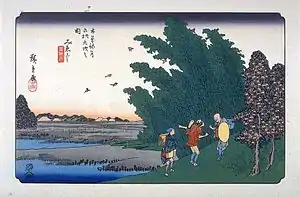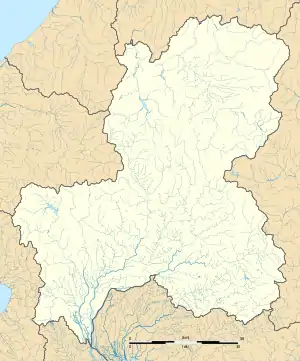Mieji-juku 美江寺宿 | |
|---|---|
| post station | |
 Hiroshige's print of Mieji-juku, part of the Sixty-nine Stations of the Kiso Kaidō series | |
| General information | |
| Location | Mizuho, Gifu (former Mino Province) Japan |
| Coordinates | 35°24′36.0″N 136°39′23.0″E / 35.410000°N 136.656389°E |
| Elevation | 10 meters |
| Line(s) | Nakasendō |
| Distance | 423.4 km from Edo |
| Location | |
 Mieji-juku Location within Gifu Prefecture  Mieji-juku Mieji-juku (Japan) | |

Mieji-juku (美江寺宿, Mieji-juku) was the fifty-fifth of the sixty-nine stations of the Nakasendō connecting Edo with Kyoto in Edo period Japan. It is located in former Mino Province in what is now part of the city of Mizuho, Gifu Prefecture, Japan.[1][2][3]
History
Mieji is surrounded by the Kiso Three Rivers: the Kiso River, Ibi River and the Nagara River and was subject to frequent flooding. A Buddhist temple called Mie-ji was constructed in 717 AD with an image of Kannon Bosatsu to pray for protection against floods, and a small village grew up around the gates of the temple. However, during the Sengoku period, Saitō Dōsan relocated the temple to his capital at Gifu. A small chapel was rebuilt, and under Toyotomi Hideyoshi a tonya was established for the supply of porters, horses and the warehousing of goods. However, it was not until 1637 that the Tokugawa shogunate officially formalized Mieji as a post station on the Nakasendō and it was not until 1669 that the honjin was completed.
Per the 1843 "中山道宿村大概帳" (Nakasendō Shukuson Taigaichō) guidebook issued by the Inspector of Highways (道中奉行, Dōchu-būgyō), the town had a population of 582 people in 136 houses, including one honjin, and 11 hatago.
The station had a bad reputation, as travelers could be trapped for days due the floods (during which time prices increased astronomically). The honjin had an elevation of only 10 meters above sea level, and was the highest point in the settlement. The eleven inns were of low standing, and were known to be frequented by thieves. Mieji was also known for the aggressiveness of its meshimori onna serving girls, who supplemented their income as prostitutes. However, the station also promoted its location on the Mino Thirty-three Kannon pilgrimage routes and was frequented by many pilgrims.
Mieji-juku in The Sixty-nine Stations of the Kiso Kaidō
Utagawa Hiroshige's ukiyo-e print of Mieji-juku dates from 1835 -1838. The print depicts a placid view of Mieji, with two farmers stopping to give directions to a traveling priest. The thatched roofs of the post station can be seen beyond a marsh with groves of bamboo and a pair of blooming Camilla trees.
Surrounding Area
The Goroku River, which ran alongside Mieji-juku, received its name from the post town. "Goroku" (五六) means "56." (Mieji-juku was the 56th stop along the Nakasendō if Nihonbashi is included.)
Neighboring Post Towns
- Nakasendō
- Gōdo-juku - Mieji-juku - Akasaka-juku
Notes
- ↑ Gifu City Walking Map. Gifu Lively City Public Corporation, 2007.
- ↑ "Archived copy". Archived from the original on 2005-03-18. Retrieved 2020-04-03.
{{cite web}}: CS1 maint: archived copy as title (link) CS1 maint: bot: original URL status unknown (link) - ↑ Mieji-juku
References
- Izzard, Sebastian (2008). The Sixty-Nine Stations of the Kisokaido. George Braziller. ISBN 978-0807615935.
- Berna, Cristina (2019). Hiroshige 69 Stations of the Nakasendō. Missys Clan. ISBN 978-2919787661.
- Kishimoto, Yutaka (2016). 中山道浪漫の旅 書き込み手帖. Shinano Mainichi Shimbun. ISBN 978-4784072972. (in Japanese)
- Yagi, Makio (2014). ちゃんと歩ける中山道六十九次 西 藪原宿~京三条大橋. 山と渓谷社. ISBN 978-4635600781. (in Japanese)